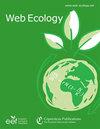中毒对秃鹫种群的影响模型表明,小而频繁的中毒事件比大而罕见的中毒事件有更大的影响
IF 2.4
3区 环境科学与生态学
Q2 ECOLOGY
引用次数: 4
摘要
摘要秃鹫是世界上最受威胁的鸟类类群之一。当秃鹫大量聚集在一起觅食时,有毒的尸体可以立即消灭整个种群。鉴于世界范围内秃鹫数量的减少,将野生或人工饲养的秃鹫放归自然的重新放养和重新引进项目是一项重要的管理工具,已在许多国家成功实施。然而,在历史范围内重建可持续的秃鹫种群仍然是一个严峻的挑战,特别是如果中毒的威胁持续存在,这通常是情况。在这项研究中,我们模拟了一个重新放养项目的结果,其中一个初始菌落受到重复中毒事件的影响。我们以塞浦路斯孤立的狮鹫秃鹫(Gyps fulvus)为例。数学考虑和模型模拟表明,群体持续存在的概率取决于初始种群规模和中毒事件的强度和频率。这种情况产生了一种阿尔利效应,需要一个群体超过最小规模才能生存。同样,在这种情况下,一系列小而频繁的中毒事件平均比几次累积死亡率相同的大而罕见的中毒事件更严重。未来加强秃鹫种群的努力应集中于释放足够数量的成年秃鹫,以成功建立可持续的种群,并应包括减少小而持久的死亡来源,如小犬科动物的毒饵,这一点迄今为止一直被保护科学家所忽视。本文章由计算机程序翻译,如有差异,请以英文原文为准。
Models of poisoning effects on vulture populations show that small but frequent episodes have a larger effect than large but rare ones
Abstract. Vultures are among the most threatened avian taxa in the world. When vultures aggregate in large numbers to feed, poisoned carcasses can extirpate entire populations at once. In the light of shrinking numbers worldwide, restocking and reintroduction projects, where wild or captive-bred vultures are released back into nature, constitute a crucial management tool, successfully implemented in many countries. However, reestablishment of sustainable vulture populations to their historical ranges remains a serious challenge, especially if the threat of poisoning persists, which is usually the case. In this study, we model the outcome of a restocking project where an initial colony is subject to repeated poisoning events. We use as an example the isolated population of the griffon vulture (Gyps fulvus) in Cyprus. Mathematical considerations and model simulations show that the probability of colony persistence depends on the initial population size and the intensity and frequency of the poisoning incidents. This type of scenario creates an Allee effect that requires a colony to exceed a minimum size in order to survive. Also in this scenario, a sequence of small but frequent poisoning episodes is worse on average than a few large and rare ones of the same cumulative mortality. Future population reinforcement efforts for vultures should focus on the release of adult birds in adequate numbers for the successful establishment of sustainable colonies and should involve a reduction in small but persistent sources of mortality such as the poison baiting of small canids that until now has been neglected by conservation scientists.
求助全文
通过发布文献求助,成功后即可免费获取论文全文。
去求助
来源期刊

Web Ecology
Agricultural and Biological Sciences-Ecology, Evolution, Behavior and Systematics
CiteScore
4.60
自引率
0.00%
发文量
6
审稿时长
17 weeks
期刊介绍:
Web Ecology (WE) is an open-access journal issued by the European Ecological Federation (EEF) representing the ecological societies within Europe and associated members. Its special value is to serve as a publication forum for national ecological societies that do not maintain their own society journal. Web Ecology publishes papers from all fields of ecology without any geographic restriction. It is a forum to communicate results of experimental, theoretical, and descriptive studies of general interest to an international audience. Original contributions, short communications, and reviews on ecological research on all kinds of organisms and ecosystems are welcome as well as papers that express emerging ideas and concepts with a sound scientific background.
 求助内容:
求助内容: 应助结果提醒方式:
应助结果提醒方式:


